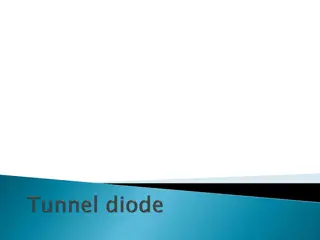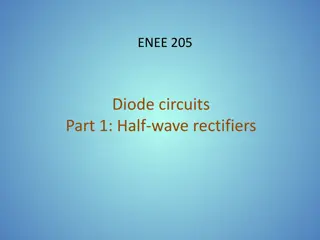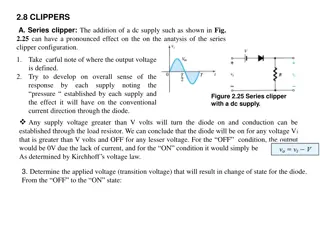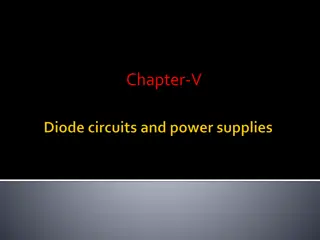Study of PN Junction Diode I-V Characteristics
In this experiment, the I-V characteristics of a PN junction diode are explored through forward and reverse bias conditions. The aim, required apparatus, circuit diagrams, procedures for forward and reverse bias, a simulator link, and observation tables are provided. The experiment involves plotting graphs and calculating dynamic resistance. Detailed steps and diagrams are included for a comprehensive understanding.
Download Presentation

Please find below an Image/Link to download the presentation.
The content on the website is provided AS IS for your information and personal use only. It may not be sold, licensed, or shared on other websites without obtaining consent from the author.If you encounter any issues during the download, it is possible that the publisher has removed the file from their server.
You are allowed to download the files provided on this website for personal or commercial use, subject to the condition that they are used lawfully. All files are the property of their respective owners.
The content on the website is provided AS IS for your information and personal use only. It may not be sold, licensed, or shared on other websites without obtaining consent from the author.
E N D
Presentation Transcript
I-V characteristics of PN Junction Diode
Aim of the Experiment Study of I-V characteristics of PN Junction Diode
Apparatus Required A PN junction diode (IN 4001, Maximum forward voltage 1.1 V, Maximum reverse voltage 50 V)* A dc voltmeter (0-20 V) A dc milli ammeter (0-100 mA) A dc micro ammeter (0-500 A) A battery (DC regulated variable power supply) A Resistor (1 k ) Bread Board Connecting wire Sandpaper 1. 2. 3. 4. 5. 6. 7. 8. 9. *Data is taken from : https://in.element14.com/on-semiconductor/1n4001g/diode-standard-1a-do- 41/dp/1458986?ost=1N4001G+ON+SEMICONDUCTOR&CMP=os_pdf- datasheet
Circuit diagram Fig (a) Forward Bias Fig (b) Reverse Bias Figure is taken from Engineering Physics 2 with laboratory practical, Dr. Nilanjan Sil, Silli Polytechnic, Silli, Jhunjhunwala publications, Jaipur
Procedure Forward Bias Characteristics 1. Connect the circuit as shown in the figure (a). 2. Switch on the regulated power supply and slowly increase the source voltage continuously and the reading is taken in steps. 3. The diode current also increases correspondingly. Note down the corresponding values of current for the given values of voltages and under forward bias condition as per observation table. 4. Plot a graph between I and V. 5. From the graph, the value of Dynamic resistance for forward bias is calculated using given the formula.
Procedure Reverse Bias Characteristics 1. Connect the circuit as shown in the figure (b). 2. Switch on the regulated power supply and slowly increase the source voltage continuously up to a limit less than breakdown voltage and reading is taken in steps. 3. The diode current is found to have very minute increase initially and thereafter it becomes almost constant with corresponding increase in voltage. Note down the corresponding values of current for the given voltages under reverse bias condition as per observation table. 4. Plot a graph between I and V.
Simulator http://vlabs.iitkgp.ac.in/be/exp5/forwardbiaseddiode_si.html http://vlabs.iitkgp.ac.in/be/exp5/
Observations I-V Characteristics for Forward Bias Table for I-V Characteristics in Forward Bias condition
Observations I-V Characteristics for Reverse Bias Table for I-V Characteristics in Reverse Bias condition
Graph between I and V A graph is plotted as current as a function of voltage in forward bias and in reverse bias. It is shown in the figure. I Forward Bias Reverse Bias The image is taken from the online source Circuit today. The link of the source is https://www.circuitstoday.com/pn-junction-diode-characteristics
Calculations Calculation for Dynamic resistance in Forward Bias Condition . V = PR = ______ I = QR = ______ Dynamic given by Rd = V / I = ______ resistance is Cut in Voltage = ____
Result Dynamic Resistance of the PN junction diode under forward bias condition Rd = ______ Cut-in voltage of the PN junction diode under forward bias condition V = _____ The reference value of Cut-in voltage of a Si diode is 0.7 V* So, the percentage error = ______ Data is taken from https://www.quora.com/What-is-the-knee-voltage-cut-in-voltage-of-a-Si-diode
Conclusion The cut in voltage under forward bias is _____. So the used diode under the lab condition is ______ The value of dynamic resistance of the PN junction diode under forward bias condition is of the order of _____
Precautions Check the wires for continuity before use. Keep the power supply at zero volts before use. Do not keep the key switch on continuously. Otherwise the resistor gets heated and its resistance changes. Switch on the key only during taking reading and then immediately switch off it. Check the voltmeter, Milli ammeter and Micro ammeter for zero error, if any. Determine the least count of voltmeter, Milli ammeter and Micro ammeter. All contacts must be tight. 1. 2. 3. 4. 5. 6.
References 1. Engineering Physics 2 with laboratory practical, Dr. Nilanjan Sil, Silli Polytechnic, Silli, Jhunjhunwala publications, Jaipur 2. Online resource Circuit today. The link is https://www.circuitstoday.com/pn-junction-diode- characteristics 3. https://in.element14.com/on-semiconductor/1n4001g/diode- standard-1a-do- 41/dp/1458986?ost=1N4001G+ON+SEMICONDUCTOR&C MP=os_pdf-datasheet 4. https://www.quora.com/What-is-the-knee-voltage-cut-in- voltage-of-a-Si-diode





















